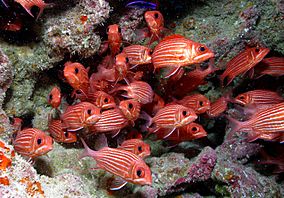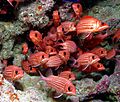Papahānaumokuākea Marine National Monument facts for kids
Quick facts for kids Papahānaumokuākea Marine National Monument |
|
|---|---|
|
IUCN Category V (Protected Landscape/Seascape)
|
|

Hawaiian squirrelfish at French Frigate Shoals, Papahānaumokuākea
|
|
| Location | Hawaii / Midway Atoll, United States Minor Outlying Islands |
| Nearest city | Honolulu, Hawaii, USA |
| Area | 140,000 square miles (360,000 km2) |
| Established | June 15, 2006 |
| Governing body | National Oceanic and Atmospheric Administration, Fish and Wildlife Service, Hawai'i Department of Land and Natural Resources |
| Type: | Mixed |
| Criteria: | iii, vi, viii, ix, x |
| Designated: | 2010 |
| Reference #: | 1326 |
| State Party: | |
| Region: | Europe and North America |
The Papahānaumokuākea Marine National Monument is a very special place in the ocean. It is also known as the Northwestern Hawaiian Islands Marine National Monument. This huge area is a World Heritage Site. This means it is protected for everyone to enjoy and learn from.
The monument covers about 140,000 square miles (360,000 km2) of ocean. This includes ten islands and atolls. It is bigger than the country of Greece.
U.S. President George W. Bush created the monument on June 15, 2006. It became a World Heritage Site on July 30, 2010.
Papahānaumokuākea is home to about 7,000 different kinds of plants and animals. About one-fourth of these species are endemic. This means they are found only in this special place and nowhere else on Earth.
Contents
What is Papahānaumokuākea?
This monument is a huge protected area in the Pacific Ocean. It covers about 583,000 square miles (1,510,000 km2) of reefs, atolls, and both shallow and deep sea. This area is larger than all of America's National Parks put together. It is also slightly bigger than Australia's Great Barrier Reef Marine Park.
The monument includes about 10 percent of all the tropical shallow water coral reef habitat in U.S. territory. The islands within the monument are part of the State of Hawaii. However, Midway Atoll is part of the United States Minor Outlying Islands. You can fly to the monument through Henderson Field on Midway Atoll.
Amazing Animals and Plants
Papahānaumokuākea is home to many unique species. About 7,000 different kinds of plants and animals live here. A quarter of these are endemic, meaning they live only in this area.
Some important animals include:
- The endangered hawksbill sea turtle
- The threatened green sea turtle
- The endangered Hawaiian monk seal
- Birds like the Laysan and Nihoa finches
- The Nihoa millerbird
- The Laysan duck
- Many seabirds, such as the Laysan albatross
You can also find many types of plants, including Pritchardia palms. There are also many kinds of arthropods, which are creatures like insects and crabs.
Protecting the Ocean Life
The monument has very strict rules to protect its wildlife. For example, Commercial fishing ended here in 2011. This helps the animal populations recover.
Some species, like lobsters, have not fully recovered from too much fishing in the past. Also, a big change in the ocean's ecosystem in the late 1980s and early 1990s affected many animals. This change reduced populations of important species like spiny lobsters, seabirds, and Hawaiian monk seals.
Even with strict rules, there are some exceptions. Native Hawaiian people can use the area for traditional purposes. Also, a small amount of tourism is allowed. These rules help keep this special ocean place healthy for the future.
Images for kids
-
Laysan and short-tailed albatrosses at Northwest Hawaiian Islands National Monument
-
Hawaiian squirrelfish at French Frigate Shoals, Papahānaumokuākea
See also
 In Spanish: Monumento nacional marino de Papahānaumokuākea para niños
In Spanish: Monumento nacional marino de Papahānaumokuākea para niños








